The Economics and Statistics Division maintains archives of previous publications for accountability purposes, but makes no updates to keep these documents current with the latest data revisions from Statistics Canada. As a result, information in older documents may not be accurate. Please exercise caution when referring to older documents. For the latest information and historical data, please contact the individual listed to the right.
<--- Return to Archive
For additional information relating to this article, please contact:
April 21, 2021ANALYSIS OF NOVA SCOTIA'S CONSUMER PRICE INDEX FOR MARCH 2021 TRENDS – March 2021
Nova Scotia’s All-Items Consumer Price Index (CPI) increased 2.8% year-over-year in March 2021. Nationally, consumer prices were up 2.2% from a year earlier.
Compared to February 2021, monthly consumer prices increased 0.7% in Nova Scotia and 0.5% in Canada.
National year-over-year CPI growth increased from 1.1% in February to 2.2% in March. A large portion of the increase was attributable to the steep declines the previous year, known as a base-year effect. The broad decline in prices at the onset of pandemic, particularly for energy products and travel services, had an upward impact on inflation the following year when the comparison is made to the same month of the previous year (March 2020) in year-over-year calculations. Statistics Canada notes that the upward impact of base-year effects will be temporary but will be affecting inflation statistics in coming months
Impact of COVID-19 on the Consumer Price Index
Statistics Canada continued special CPI program measures for March2021. Due to COVID-19 impact on product availability, select sub-components of the CPI received temporary special imputations. The sub-indexes for travel tours, components of spectator entertainment, recreational services, personal care services in some areas, and some components of use of recreational facilities and services in some areas were imputed from the monthly change in the all-items index - effectively removing the impact of these goods and services on the CPI. The price indexes for beer, wine and liquor served in licensed establishments were imputed in several regions, using the indexes to which consumers likely redirected their expenditures: beer, wine and liquor purchased from stores. Consistent with previous months affected by the COVID-19 pandemic, prices for suspended flights are excluded from the March CPI calculation because passengers were ultimately unable to consume them. As a result, selected sub-components of the air transportation index were imputed from the parent index (air transportation).
Prices increased year-over-year in all provinces led by Prince Edward Island (+3.3%). Manitoba had the slowest growth (+1.6%).
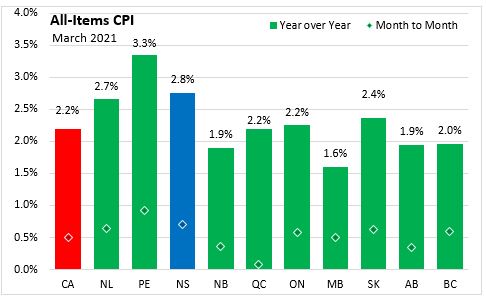
The main contributors to the monthly change (March 2021 vs. February 2021) in Nova Scotia CPI were:
- Gasoline (+8.2%)
- Fuel oil and other fuels (+9.6%)
- Homeowners' replacement cost (+3.0%)
- Telephone services (-8.6%)
- Purchase and leasing of passenger vehicles (-0.4%)
- Food purchased from restaurants (-0.6%)
The main contributors to the yearly change (March 2021 vs. March 2020) in Nova Scotia CPI were:
- Gasoline (+45.8%)
- Homeowners' replacement cost (+10.6%)
- Purchase and leasing of passenger vehicles (+3.6%)
- Telephone services (-18.5%)
- Women's clothing (-11.7%)
- Traveller accommodation (-22.7%)
Nova Scotia’s consumer price inflation (year-over-year) excluding food and energy increased 1.2% in March. Consumer prices excluding food and energy were down in two provinces, Manitoba and Alberta (both -0.1%). The largest increase in CPI excluding food and energy was in Saskatchewan (+1.5%).
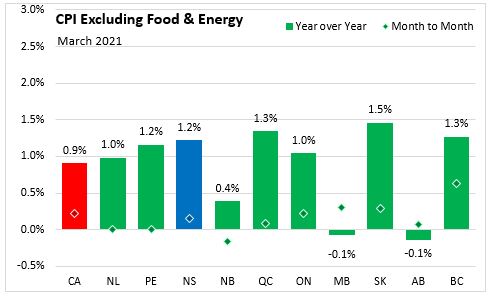
The CPI for food in Nova Scotia increased 1.7% year-over-year in March compared to the national average of 1.8%. Prince Edward Island posted the largest increase (+3.6%). Food prices decreased 0.1% month-over-month nationally in March while Nova Scotia increased 0.6%.

Nova Scotia energy prices increased 20.0 year-over-year in March compared to the national average 19.1%. All provinces reported double digit increases in energy prices. Nationally, gasoline prices increased 35.3% year-over-year, the largest gain since March 2000. Lower prices in March 2020 contributed to the year-over-year increase due to the base-year effect and there was also growing global oil demand and continued production cuts by the Organization of the Petroleum Exporting Countries Plus.
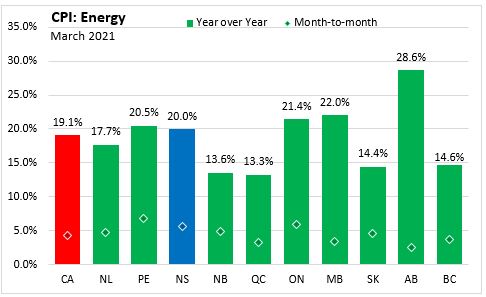
Year-over-year, shelter costs in Nova Scotia increased 3.0% in March, above the national average increase of 2.4%. Compared to March 2020, shelter prices were up in all provinces with the largest increase in Prince Edward Island (+3.8%) and the smallest increase in Saskatchewan (+0.3%).
Statistics Canada noted that the building materials and demand for single-family homes continues to grow, pushing up the homeowners replacement cost index (around 5% of the CPI basket weight). Nationally, the homeowners replacement costs increased 7.9% and in Nova Scotia was up 10.6% year-over-year. This is partially offset by the decline in mortgage interest cost index over the past year. Rent prices rose in Atlantic Canada with higher demand from increased migration and fewer homes for sale, the rent increase in the region was highest in New Brunswick (+4.8%) and smallest in Nova Scotia (+2.0%).
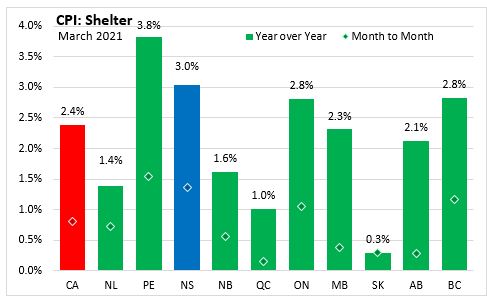
Nova Scotia's consumer price inflation (year-over-year growth in CPI) excluding energy was 1.3% in March compared to a national rate of 1.1%. Prince Edward Island (+1.6%) posted the largest year-over-year gain while the CPI excluding energy had the smallest change in Alberta (+0.2%).
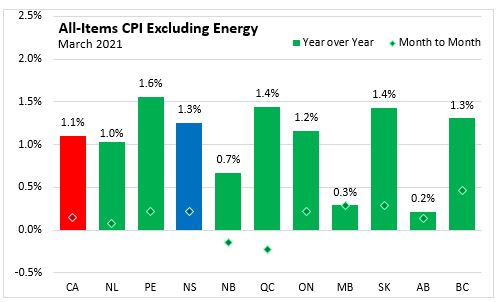
Major Components for March 2021
The following table shows the price increases specific to Nova Scotia for the major components of the CPI this month:
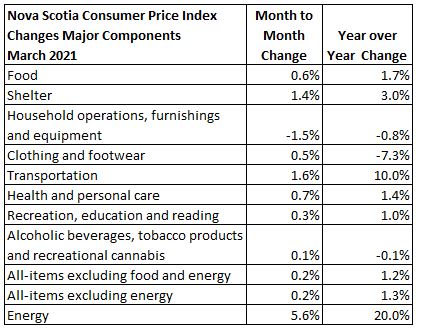
Long Run Trends
In March 2021, the All-Items CPI year-over-year inflation rate for Nova Scotia was 2.8%, above Canada's average rate at 2.2%. Nova Scotia's annual inflation has mostly been below the Canadian average since mid-2014, with the exception of only a few months. While month-to-month movements in the indices can be different, over time they generally follow the same overall trend.

Annual inflation for the CPI excluding food and energy in Nova Scotia (+1.2%) was higher than the national rate (+0.9%) in March 2021.
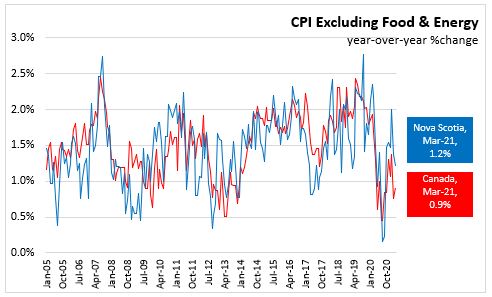
Bank of Canada's preferred measures of core inflation
Compared to March 2020, CPI-Common increased 1.5%, CPI-Median rose 2.1% and CPI-Trim was up 2.2% in Canada. All-items CPI excluding eight of the most volatile components as defined by the Bank of Canada and excluding the effect of changes in indirect taxes (formerly referred to as CPIX), rose 1.4% year-over-year. All the indexes year-over-year change were higher in March 2021 than last month.
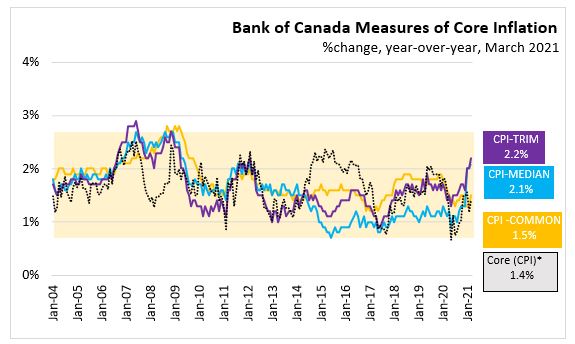
Appendix Tables and Charts

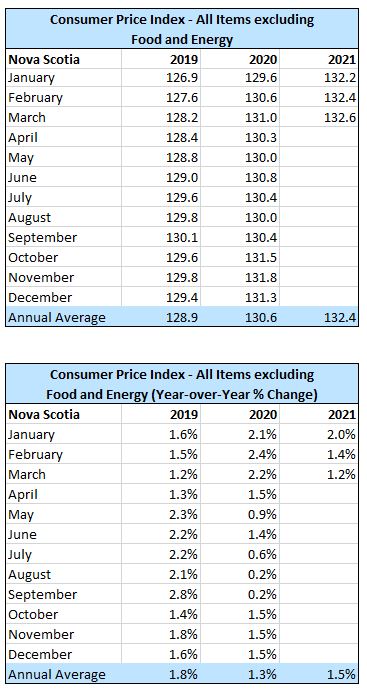
Source: Statistics Canada data portal: Tables 18-10-0004-01 and 18-10-0256-01
<--- Return to Archive